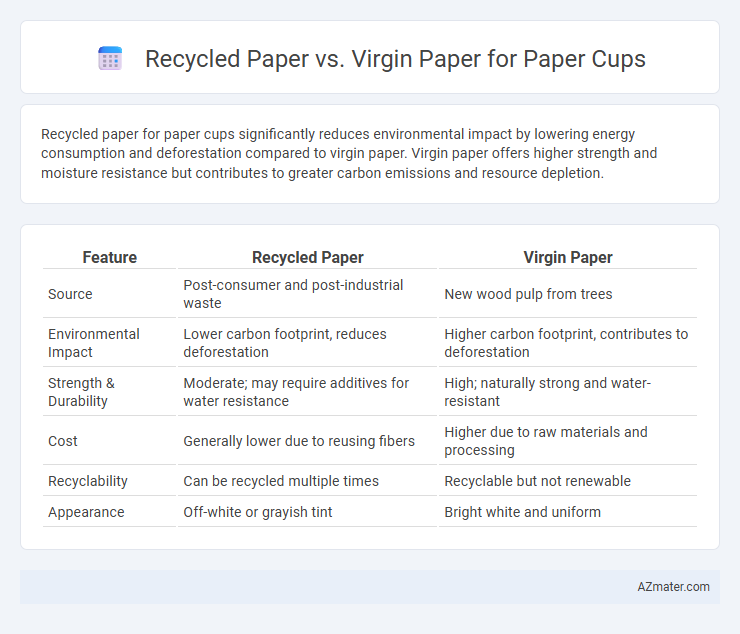Recycled paper for paper cups significantly reduces environmental impact by lowering energy consumption and deforestation compared to virgin paper. Virgin paper offers higher strength and moisture resistance but contributes to greater carbon emissions and resource depletion.
Table of Comparison
| Feature | Recycled Paper | Virgin Paper |
|---|---|---|
| Source | Post-consumer and post-industrial waste | New wood pulp from trees |
| Environmental Impact | Lower carbon footprint, reduces deforestation | Higher carbon footprint, contributes to deforestation |
| Strength & Durability | Moderate; may require additives for water resistance | High; naturally strong and water-resistant |
| Cost | Generally lower due to reusing fibers | Higher due to raw materials and processing |
| Recyclability | Can be recycled multiple times | Recyclable but not renewable |
| Appearance | Off-white or grayish tint | Bright white and uniform |
Introduction to Recycled vs Virgin Paper in Paper Cup Manufacturing
Recycled paper, derived from post-consumer and post-industrial waste, offers a sustainable alternative to virgin paper, which is produced directly from fresh wood pulp in paper cup manufacturing. Virgin paper ensures higher strength and uniformity, making it favorable for single-use paper cups requiring robust barrier properties. Recycled paper reduces environmental impact by conserving natural resources and decreasing energy consumption, aligning with eco-friendly production practices in the paper cup industry.
Environmental Impact: Recycled vs Virgin Paper
Recycled paper for paper cups significantly reduces deforestation and conserves natural resources by reusing fibers, lowering overall carbon emissions by up to 50% compared to virgin paper. Virgin paper production requires more water, energy, and chemical inputs, leading to higher greenhouse gas emissions and greater pollution in water bodies. Choosing recycled paper cups minimizes landfill waste and supports sustainable forestry practices, contributing to a lower environmental footprint.
Raw Material Sourcing for Paper Cups
Raw material sourcing for paper cups involves choosing between recycled paper and virgin paper, each impacting environmental sustainability differently. Recycled paper reduces deforestation and limits landfill waste by repurposing post-consumer fibers, while virgin paper relies on fresh wood pulp often sourced from managed forests or plantations. Selecting recycled paper supports circular economy practices and lowers the demand for raw timber, crucial for minimizing the carbon footprint and conserving natural resources in paper cup production.
Energy Consumption and Carbon Footprint Comparison
Recycled paper used in paper cup production consumes up to 60% less energy compared to virgin paper, significantly reducing overall carbon emissions. Virgin paper manufacturing requires extensive deforestation and intensive pulping processes, leading to a higher carbon footprint of approximately 2.5 times that of recycled alternatives. Utilizing recycled paper for paper cups supports energy efficiency and decreases greenhouse gas emissions, making it a more sustainable choice.
Water Usage: Recycled Paper vs Virgin Paper Production
Recycled paper production for paper cups uses up to 70% less water compared to virgin paper manufacturing, significantly reducing environmental impact. Virgin paper production requires large volumes of water for pulping and bleaching processes, leading to higher water consumption and potential pollution. Choosing recycled paper helps conserve freshwater resources and supports sustainable manufacturing practices in the paper cup industry.
Quality and Performance in Paper Cups
Recycled paper in paper cups often has a lower fiber strength compared to virgin paper, potentially affecting cup durability and resistance to liquid absorption. Virgin paper provides superior structural integrity and smoother surface finish, enhancing print quality and cup performance under high temperatures. While recycled paper promotes sustainability, virgin paper remains the preferred choice for premium paper cups requiring optimal quality and performance.
Food Safety and Regulatory Compliance
Recycled paper used in paper cups must meet stringent food safety standards such as FDA 21 CFR and EFSA regulations to prevent contamination from inks, adhesives, and chemical residues. Virgin paper offers a more controlled and inert material source, reducing the risk of chemical migration and ensuring consistent compliance with food contact material laws. Both materials require certification like FDA approval or compliance with EU food contact regulations to guarantee consumer safety and regulatory adherence.
Cost Analysis: Recycled vs Virgin Paper for Paper Cups
Recycled paper for paper cups generally offers lower raw material costs compared to virgin paper due to the use of post-consumer waste, reducing reliance on timber and minimizing production expenses. However, recycled fibers may require additional processing to meet food safety and strength standards, which can increase manufacturing costs slightly. Virgin paper typically demands higher upfront costs because of raw material extraction and processing, but it provides consistent quality and performance that can reduce waste and defects in large-scale paper cup production.
Consumer Perception and Market Trends
Consumer perception of recycled paper for paper cups highlights growing environmental awareness, with many favoring sustainable options to reduce waste and carbon footprint. Market trends reveal an increasing demand for recycled paper products, driven by corporate sustainability goals and government regulations promoting eco-friendly packaging. However, some consumers still associate virgin paper with higher quality and durability, influencing brand strategies to balance sustainability with product performance.
Sustainability and Future Outlook for Paper Cup Materials
Recycled paper significantly reduces deforestation and energy consumption compared to virgin paper, making it a more sustainable choice for paper cup production. Advances in recycling technology and biodegradable coatings are enhancing the quality and environmental impact of recycled paper cups. The future outlook favors recycled paper as manufacturers and consumers increasingly prioritize circular economy practices and carbon footprint reduction in paper cup materials.

Infographic: Recycled paper vs Virgin paper for Paper cup
 azmater.com
azmater.com